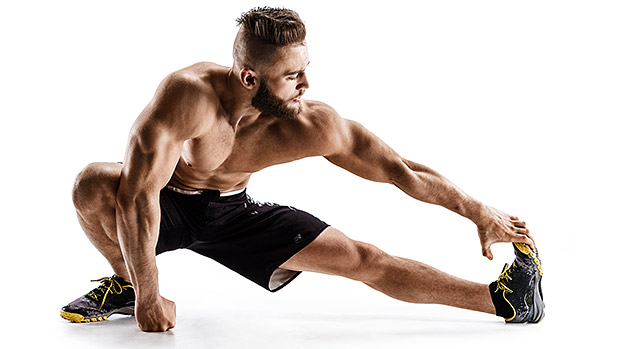About a dozen years ago or so, word trickled down from sports academia that doing static stretching before a lift was plumb stupid, that it would weaken us. Those of us supposedly in the know abandoned pre-lift stretching immediately, but a lot of guys didn't get the message. These dimwits continued to hold stretches before a lift and we'd shake our heads in mock pity but were secretly happy that we had yet another thing to feel superior about.
It turns out this is one case where being out of the research pipeline might have been a blessing because new research shows that doing a static-hold stretch before a lift doesn't hurt performance and might even increase it, as long as it's done for precisely the right amount of time.
What They Did
Ebadi and Cetin recruited 15 athletes (10 from football and 5 from basketball) and had them participate in a complex static stretching program for quadriceps, hamstrings, calves, adductors, and hip rotators.
The subjects were divvied up into four groups. Each group did a 5-minute jog (warm-up), followed by:
- No stretching at all
- Holding each static stretch for 15 seconds
- Holding each static stretch for 30 seconds
- Holding each static stretch for 45 seconds
After stretching, or in the case of group A, not stretching at all, the subjects had their isokinetic strength measured via an Isomed 2000. (Isokinetic machines measure force and increase the load when they sense muscle contraction is speeding up.)
What They Found
Five minutes of jogging followed by 15 seconds of static stretching increased isokinetic strength, whereas 30 and 45 seconds of static stretching caused a decrease in isokinetic strength.
What This Means To You
The concept behind stretching has always been that it has positive effects on joint mobility, leading to increased performance. After all, if you can't position your shoulder correctly due to mobility restrictions, you're not going to be able to press or row efficiently. By the same token, squatting or deadlifting with tight hip flexors will make you look like aging waterfowl.
But, despite these intuitive beliefs in the merits of static stretching, previous research told us that it wasn't true; that we could do a warm-up and maybe some ballistic stretching but no static stretching, not even tying your shoe while standing up because, by God, that's a static stretch and that would sap us of our strength and that squat bar would squash us into tapioca.
The previous research wasn't actually wrong, but it was incomplete, and the researchers weren't guilty of incompetence, but a lack of imagination. They didn't think to test short-duration static stretching. If they had, we'd probably all still be doing static stretching before certain lifts to improve performance, but only for periods of 15 seconds.
No need to be so anal about this, though. If you stretch before an exercise, count for somewhere between 12 and 20 Mississippis.
Reference
- Leyla Alizadeh Ebadi and Ebru Çetin, "Duration Dependent Effect of Static Stretching on Quadriceps and Hamstring Muscle Force," Sports 2018, 6(1), 24.





